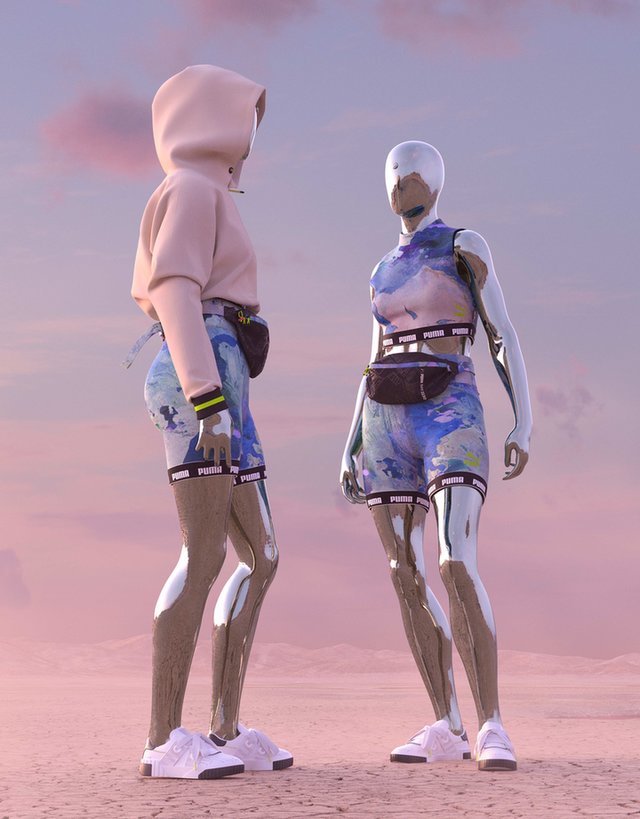
The Fabricant x PUMA
The Digital Goods Economy is Thriving. Are You Ready To Take Part?
2023 has dawned and those outside the industries related to the digital goods economy have been left uncertain about the evolution of the metaverse. Reasonably asking, what happens next? How do we get involved? Is it here yet?
The metaverse hype train hurtled into overdrive late in 2021 when Meta, formerly known as Facebook, made a spectacular land grab for the future of the internet by rebranding and refocusing its attention on all things metaverse. Companies that had been working hard for years to build the new virtual goods economy were taken aback, ourselves included (The Fabricant has created digital-only fashion collections since 2018), but it put an undeniable spotlight on the fact that digital goods are sharply in the ascendant. Ask an 11-year-old about their gift wishlist and you’ll hear them mention ‘skins’ as often as they mention a physical item; digital outfits designed to wear on a gaming avatar in virtual worlds.
2022 saw a rapid maturing of the space and the language around it. ‘Metaverse’ gave way to the phrase ‘Web3’, and the term ‘NFT’ was deemed too techy and intimidating, with brands instead adopting ‘digital collectible’ or ‘digital asset’ as their preferred descriptors, setting the stage for an era in which digital consumables are primed for mass adoption.
The stage is set for an era in which digital consumables are primed for mass adoption. Aspiring brands, get ready to build the next 200 years of your brand story, activating a new generation of consumers who are digitally savvy, while opening up new revenue streams in digital goods.

The prospect that digital collectibles will outstrip demand for physical goods isn’t outlandish. Wall Street predicts the Web3 economy to be worth between $8 and $13 trillion by 2030, with digital fashion leading the charge. New business models such as ‘direct-to-avatar’ are being established, where your digital identity, backed by a crypto currency-enabled wallet, can indulge in spectacular digital garments and other metaverse must-haves untroubled by real world supply chains.
Bullish predictions for the space have seen physical retailers place strong emphasis on activities that enable their Web3 capacity. Yves St. Laurent is the latest big name to future-proof its brand by filing trademark applications for its name and logo in the metaverse. The brand’s makeup, skin care, toiletries and cosmetics will be available for use in virtual worlds, while its retail stores will also feature virtual goods. It follows similar moves made by fellow luxury players including Gucci, Rolex, Hermes and Mercedes Benz, as well as Nike and Adidas. A host of celebrities have also spotted the opportunity to further exploit their IP and reputation, with Scottie Pippen being the latest to capitalize. His 1000-piece collection of digital-only sneakers was an instant sell-out to fans hungry to own a piece connected to the basketball legend.
But what about aspirant brands who are yet to take their initial steps in the Web3 space? Is it a case of sink or swim in a world of the techy and unfamiliar?
The smart route for retailers of any physical product is to collaborate with an established Web3 entity that specializes in onboarding brands into the space. They have the tech insight and cultural knowledge to make the transition as frictionless as possible. The key component is a community that is ready and able to participate in a brand’s activation, with an already established level of trust to deliver innovative collaborations.
The compelling proposition for established physical world players entering the Web3 arena is the capacity to build the next 200 years of their brand story, activating a new generation of consumers who are digitally savvy, while opening up new revenue streams in digital goods.
The business reality is that we are still in an early transitionary phase towards the fuller concept of Web3 and the promise of an immersive internet - we’re in Web2.5 right now, essentially. The time is ripe to ensure your brand is ready when the fully-realized metaverse arrives.




Michaela Larosse is Head of Content at The Fabricant, established as the world’s first digital-only fashion house in 2018. She has a background as a business journalist specialized in the creative industries and is a conceptual creator for global brand campaigns. Her role at The Fabricant sees Michaela shape its brand strategy and narrative, as well as leading its communications across all its channels.